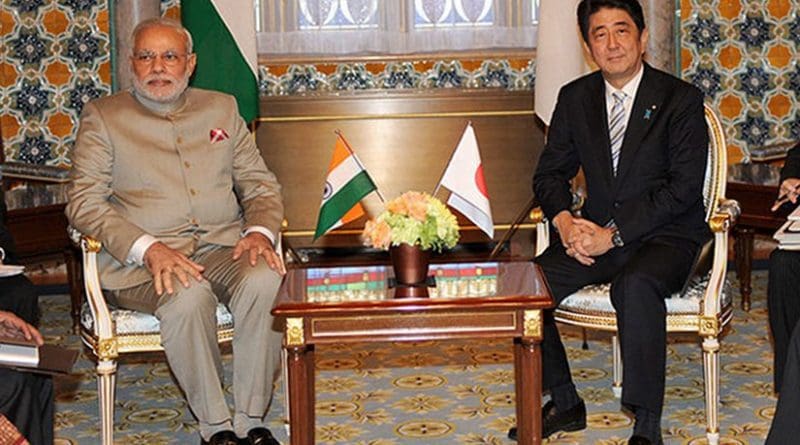Will Geopolitics ‘Trump’ The Modi-Abe Bilateral Agenda? – Analysis
Indian Prime Minister Narendra Modi is in Japan to seal a landmark nuclear energy pact and strengthen ties under the cloud of Trump’s “America First” campaign promise, which has raised concerns about a reduced US engagement with the region. It is also the time when China’s regional influence has received a boost post the South China Sea (SCS) arbitration ruling through recent visits by the leaders of Philippines and Malaysia who have sought closer relations with China. The question is will geopolitics imperatives ‘trump’ the India-Japan bilateral agenda?
The last two summits saw the two countries carrying forward their relations to new levels. Following their 2014 summit meeting, both Modi and Abe issued the Tokyo Declaration which termed the relationship as a “special strategic and global partnership” opening new vistas for cooperation. During the 2015 New Delhi summit the two leaders spelt out the India-Japan Vision 2025 that talked about an action oriented partnership. The current visit is expected to see about 12 pacts signed as the two countries broaden their engagement across a wide range of interests, including regional cooperation, maritime security, counter terrorism, nuclear disarmament, U.N. reforms, climate change and energy cooperation.
The nuclear energy pact which will allows Japan to supply nuclear reactors, fuel and technology to India, has been a subject of tight negotiations for over last six years. If signed it will be Japan’s first nuclear energy pact with a country which is not a signatory to the nuclear Non-Proliferation Treaty (NPT). Another significant item on the agenda is a deal on the supply of amphibious rescue aircraft US-2 to the Indian navy, which would be one of Japan’s first sales of military equipment since Abe lifted a 50-year ban on arms exports. Also in sight is a deal for a second bullet train project. Japan is already a partner for India’s first line, the 980-billion-rupee ($15 billion) rail linking Mumbai and Ahmedabad. But geopolitical issues continue to bear on the visit.
On the eve of Modi’s departure to Tokyo, the Chinese state-controlled Global Times had warned that it would be “a serious mistake” by India to raises the South China Sea (SCS) issue in the India-Japan joint statement. Such a move is seen as retaliation against China’s repeated actions to block India’s bid to become a member of the Nuclear Suppliers Group (NSG). From the Chinese viewpoint, as a non-claimant to the SCS, India is not part of the ongoing disputes between China and other countries in the region and intervention on the issue will only create more “mistrust” between the two Himalayan neighbours. Japan on the other hand has its own geopolitical worries.
The change in the US presidency is not likely to effect a radical departure in the US Asia policy away from the four pillars of Obama’s rebalance to Asia; building alliances and partnerships, strengthening regional institutions, deepening economic engagement , and promoting democracy and human rights. Obama had defined the current dispute between Japan and China over the Senkaku islands as falling under the provisions of the US-Japan defensive alliance. This would mean that US would view any Chinese incursion in the Senkakus as an assault on the Japanese home islands. Trump could reverse this position as a part of his China policy, and not automatically respond in Japan’s favour if the country got into a spat with China over the disputed islands. As things stand today, no country is going to be as profoundly affected by the Trump presidency as Japan.
Trump has indicated through his ‘America first’ rhetoric to adopt a more transactional approach to existing alliances and partnerships, largely in terms of increased burden-sharing .In the case of Japan this would mean an end to the “free ride” and that it would be expected to do more for its defence and security. Though it may not lead to the end of US deployment in Japan and the country ‘going nuclear,’ as Trump had indicated, but will require Japan to balance its reliance on US military support by other alliances and partnerships including that with India.
The other player in the region, South Korea in the meanwhile has indicated that it is going ahead with the deployment on its soil of the US military’s Terminal High Altitude Area Defence (THAAD) anti-missile system, under the Trump administration. The THAAD is designed to counter North Korea’s missile threat. Washington and Seoul had agreed to deploy the THAAD system in South Korea to protect against North Korean threats despite China’s warnings to South Korea against its deployment. The South Korean decision to go ahead with the deployment against Chinese wishes comes amid apprehension over what shape Trump’s policy to deal with North Korea is likely to take. The South Korean decision is likely to prompt a more aggressive Chinese stance in East Asia.
Given China’s economic heft, particularly in Asia, any China-centric security understanding between India and Japan is bound to have trade and economic consequences for both India and Japan . China on the other hand is bound to play this factor to disincentive any regional move to undermine its dominance.
The next two days are likely to indicate how Modi and Abe prioritise and negotiate their security and geopolitical imperatives while charting a course towards a stronger economic and developmental cooperation within the India-Japan Vision 2025.
*Monish Gulati is Associate Director (Strategic Affairs) at Society for Policy Studies, New Delhi. Comments and suggestions on this article can be sent on: [email protected]

